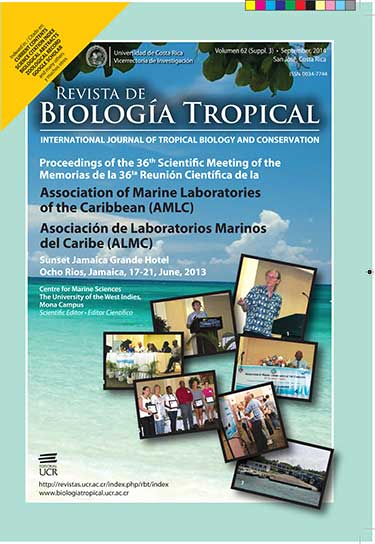Abstract
The recent invasion of lionfish (Pterois volitans) in the Atlantic is considered a new threat to benthic and fish communities in the Caribbean region. This species was first reported in Venezuela in 2009 at various sites. Increasing reports in the past five years suggest lionfish has expanded its range of distribution and habitats. Nevertheless, this information is mostly anecdotal and extensive surveys aimed to determine its abundance, size structure and other ecological aspects encompassing wider spatial scales are necessary to understand the actual role of this species on sub-tidal marine communities in Venezuela. We determined its density and population size structure through visual census along the Venezuelan coast. Visual censuses were made following strip transects at a depth between 5 and 20m and in daylight time, at 19 sites in five localities. Average density ranged between 7 to 55 individuals per hectare among sites. Most individuals were adults and most were found in caves, coexisting with other lionfish or with different species, while others were actively preying. The fish Pterois volitans seems to be well-established along the Venezuelan coast in densities that in some sites appear to be higher than in their Pacific native range but lower than in some invaded localities of the Atlantic. Rev. Biol. Trop. 62 (Suppl. 3): 151-158. Epub 2014 September 01.References
Albins, M. A. & Hixon, M. A. 2011. Worst case scenario: potential long-term effects of invasive predatory lionfish (Pterois volitans) on Atlantic and Caribbean coral-reef communities. Env. Bio. of Fishes.
Albins, M. & Hixon, M. 2008b. Invasive Indo-Pacific lionfish Pterois volitans reduce recruitment of Atlantic coral-reef fishes. Mar. Ecol. Prog Ser. 367: 233–238.
Anderson, M. J. 2005. Permutational multivariate analysis of variance. Department of Statistics, University of Auckland, Auckland. Retrieved from http://www.stat.auckland.ac.nz/~mja/prog/PERMANOVA_UserNotes.pdf
Côté, I., & Maljkovic, A. 2010. Predation rates of Indo-Pacific lionfish on Bahamian coral reefs. Mar. Ecol. Prog. Ser. 404: 219-225.
Darling, E. S., Green, S. J., O’Leary, J. K., & Côté, I. M. 2011. Indo-Pacific lionfish are larger and more abundant on invaded reefs: a comparison of Kenyan and Bahamian lionfish populations. Biol. Inv. 13(9), 2045-2051.
Fishelson, L. 1997. Experiments and observations on food consumption, growth and starvation in Dendrochirus brachypterus and Pterois volitans (Pteroinae, Scorpaenidae). Env. Bio. of Fishes, 50(4), 397-403.
Ginsburg R., Kramer P., Lang J., Salle P. Steneck R. 1998. Atlantic and Gulf Rapid Reef Assesment (AGRRA). (http://agrra.org).
Green S., N. Tamburello, S. Miller, J. Akins, I. Côté. 2013. Habitat complexity and fish size affect the detection of Indo-Pacific lionfish on invaded reefs. Coral Reefs 32,413-421
Gurevitch, J., & Padilla, D. 2004. Are invasive species a major cause of extinctions? Trends Ecol. Evolut. 19(9), 470-474.
Hamner, R. M., Freshwater, D. W., & Whitfield, P. E. 2007. Mitochondrial cytochrome b analysis reveals two invasive lionfish species with strong founder effects in the western Atlantic. J. Fish Biol. 71, 214–222.
Kulbicki M, Beets J, Chabanet P, Cure K, Darling E, Floeter SR, Galzin R, Green A, Harmelin, Vivien M, Hixon M, Letourneur Y, Lison de Loma T, McClanahan T, McIlwain J, MouTham G, Myers R, O’Leary JK, Planes S, Vigliola L, Wantiez L. 2012. Distributions of Indo-Pacific lionfishes Pterois spp. in their native ranges: implications for the Atlantic invasion. Mar. Ecol. Prog. Ser. 446, 189-205.
Lasso-Alcalá, O., & Posada, J. 2010. Presence of the invasive red lionfish, Pterois volitans (Linnaeus, 1758), on the coast of Venezuela, southeastern Caribbean Sea. Aquatic Invasions, 5(Supplement 1), S53–S59.
Lesser, M. P., & Slattery, M. 2011. Phase shift to algal dominated communities at mesophotic depths associated with lionfish (Pterois volitans) invasion on a Bahamian coral reef. Biol. Invasions. 13(8), 1855-1868.
López-Ordaz, A., Ortaz, M., & Rodriguez-Quintal, J. G. (2009). Trama trófica de una comunidad de peces en una pradera marina en el Caribe Venezolano. Rev. Biol. Trop. 57(4), 963-975.
Ruiz, G. M., Carlton, J. T., Grosholz, E. D., & Hines, A. H. 1997. Global invasions of marine and estuarine habitats by non-indigenous species: mechanisms, extent, and consequences. Amer. Zoo. 37(6), 621-632.
Schofield, P. 2009. Geographic extent and chronology of the invasion of non-native lionfish (Pterois volitans [Linnaeus 1758] and P. miles [Bennett 1828]) in the Western North Atlantic and Caribbean Sea. Aquat. Inv. 4(3), 473-479.
Schofield, P. 2010. Update on geographic spread of invasive lionfishes (Pterois volitans [Linnaeus, 1758] and P. miles [Bennett, 1828]) in the Western North Atlantic Ocean, Caribbean Sea and Gulf of Mexico. Aquat. Inv. 5(Supplement 1), S117-S122.
Whitfield, P. E., Gardner, T., Vives, S. P., Gilligan, M. R., Courtenay Jr, W. R., Ray, G. C., & Hare, J. A. 2002. Biological invasion of the Indo-Pacific lionfish Pterois volitans along the Atlantic coast of North America. Mar. Ecol. Prog. Ser. 235, 289-297.
##plugins.facebook.comentarios##

This work is licensed under a Creative Commons Attribution 4.0 International License.
Copyright (c) 2014 Revista de Biología Tropical






